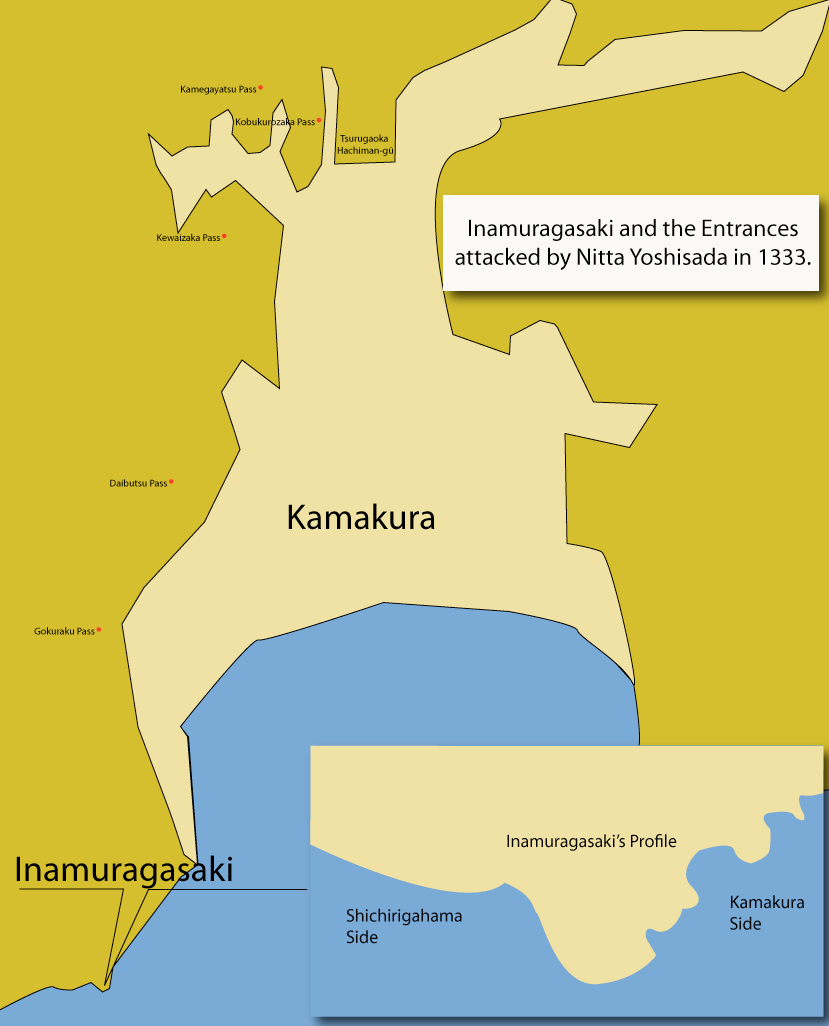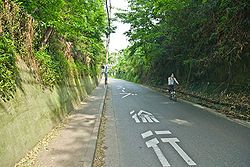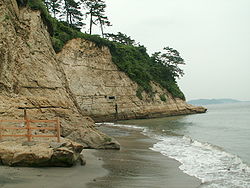
Inamuragasaki
Encyclopedia

Yuigahama
is a beach near Kamakura, a city in Kanagawa Prefecture, Japan. The relation between the beach and its neighboring areas is complex. Although Yuigahama is in fact the entire 3.2 km beach that goes from Inamuragasaki, which separates it from Shichirigahama, to Zaimokuza's Iijima cape, which...
(Beach) in Kamakura
Kamakura, Kanagawa
is a city located in Kanagawa Prefecture, Japan, about south-south-west of Tokyo. It used to be also called .Although Kamakura proper is today rather small, it is often described in history books as a former de facto capital of Japan as the seat of the Shogunate and of the Regency during the...
, Kanagawa Prefecture
Kanagawa Prefecture
is a prefecture located in the southern Kantō region of Japan. The capital is Yokohama. Kanagawa is part of the Greater Tokyo Area.-History:The prefecture has some archaeological sites going back to the Jōmon period...
, Japan
Japan
Japan is an island nation in East Asia. Located in the Pacific Ocean, it lies to the east of the Sea of Japan, China, North Korea, South Korea and Russia, stretching from the Sea of Okhotsk in the north to the East China Sea and Taiwan in the south...
. The cape divides Yuigahama from Shichirigahama
Shichirigahama
is a beach near Kamakura, Kanagawa prefecture, Japan, which goes from Koyurigimisaki Cape, near Fujisawa, to Inamuragasaki Cape, west of Kamakura. Since one could enjoy a clear view of Mount Fuji and Enoshima from there, during the Edo period it was famous as a subject for ukiyo-e. For example,...
(Beach) and Enoshima
Enoshima
is a small island, about 4 km in circumference, at the mouth of the Katase River, which flows into Sagami Bay in Japan. Part of the city of Fujisawa, it is linked to the Katase section of the same city on the mainland by a 600 meter-long bridge...
. Its name seems to stem from its shape, similar to a stack of rice at harvest time (an ). At its foot on the Shichirigahama side there is a park, the .
History

Tokaido (road)
The ' was the most important of the Five Routes of the Edo period, connecting Edo to Kyoto in Japan. Unlike the inland and less heavily travelled Nakasendō, the Tōkaidō travelled along the sea coast of eastern Honshū, hence the route's name....
highway passed along the sea south of this cape before heading to the Miura Peninsula
Miura Peninsula
is a peninsula located in Kanagawa, Japan. It lies south of Yokohama and Tokyo and divides Tokyo Bay, to the east, from Sagami Bay, to the west. Cities and towns on the Miura Peninsula include Yokosuka, Miura, Hayama, Zushi, and Kamakura....
, before the opening of the Gokuraku Pass Inamuragasaki was the traditional point of entry to Kamakura at the time of the Kamakura shogunate
Kamakura shogunate
The Kamakura shogunate was a military dictatorship in Japan headed by the shoguns from 1185 to 1333. It was based in Kamakura. The Kamakura period draws its name from the capital of the shogunate...
. Now crossed by a road (see photo), it used to be impassable by land and was therefore one of the natural defenses that made Kamakura an impregnable fortress.
For this reason, it appears often in the historical record. It is first mentioned in the Genpei Jōsuiki
Genpei Josuiki
The , is a 48-book extended version of the Heike Monogatari. -External links:* , University of Virginia Library...
because the Miura clan
Miura clan
The ' was one of the branch families descended from the Taira clan. They held large fiefs, and great political influence. They were one of the primary opponents of the Hōjō family of regents, in the mid-13th century, and again at the beginning of the 16th...
in 1180 crossed it twice to go rescue Minamoto no Yoritomo
Minamoto no Yoritomo
was the founder and the first shogun of the Kamakura Shogunate of Japan. He ruled from 1192 until 1199.-Early life and exile :Yoritomo was the third son of Minamoto no Yoshitomo, heir of the Minamoto clan, and his official wife, a daughter of Fujiwara no Suenori, who was a member of the...
at the battle of Ishibashiyama
Battle of Ishibashiyama
The ' was the first in which Minamoto Yoritomo, who was to become shogun less than a decade later, was commander of the Minamoto forces. In this, his first attempt to challenge the Taira, he was assisted by warriors from the Miura clan....
. The troops didn't arrive in time, Yoritomo was defeated and the Miura had to go back the way they had come.
The cape then appears in the because its author in 1223 passed it to enter Kamakura. Inamuragasaki is also mentioned in the Azuma Kagami
Azuma Kagami
The , or "mirror of the east", is a Japanese medieval text that chronicles events of the Kamakura Shogunate from Minamoto no Yoritomo's rebellion against the Taira clan in Izokuni of 1180 to Munetaka Shinnō and his return to Kyoto in 1266...
, the Man'yōshū, the Heike Monogatari and the Taiheiki
Taiheiki
The is a Japanese historical epic , written in the late 14th century. It deals primarily with the Nanboku-chō, the period of war between the Northern Court of Ashikaga Takauji in Kyoto, and the Southern Court of Emperor Go-Daigo in Yoshino....
, although the first two call it with its old name, .
Finally, Nitta Yoshisada
Nitta Yoshisada
was the head of the Nitta family in the early fourteenth century, and supported the Southern Court of Emperor Go-Daigo in the Nanboku-chō period, capturing Kamakura from the Hōjō clan in 1333....
made it immortal in Japanese culture bypassing it on the evening of July 3, 1333 to invade Kamakura, bringing the Kamakura shogunate
Kamakura shogunate
The Kamakura shogunate was a military dictatorship in Japan headed by the shoguns from 1185 to 1333. It was based in Kamakura. The Kamakura period draws its name from the capital of the shogunate...
to an end. For this reason, it has been nominated a Historic Site by the Japanese government.

Kamakura Kaido
is the generic name of a great number of roads built during the Kamakura period which, from all directions, converged on the military capital of Kamakura, Kanagawa Prefecture, Japan. The term itself however was created probably during the Edo Period to mean simply any old road going to Kamakura; it...
's northern course (the ), fighting the Hōjō along the way Arrived in Kamakura, they first tried to enter through the Gokuraku, Kobukorozaka and Kewaizaka Passes
Kamakura's Seven Entrances
The city of Kamakura, Kanagawa in Japan, is closed off on three sides by very steep hills and on the fourth by the sea: before the construction of several modern tunnels and roads, the so-called Seven Entrances , or were its main links to the rest of the world...
, but concentrated Hōjō
Hojo clan
See the late Hōjō clan for the Hōjō clan of the Sengoku Period.The in the history of Japan was a family who controlled the hereditary title of shikken of the Kamakura Shogunate. In practice, the family had actual governmental power, many times dictatorial, rather than Kamakura shoguns, or the...
forces managed to stop them. Judging it impossible to enter by land, Nitta decided to try bypassing Inamuragasaki.
The Taiheiki version of the events
According to the TaiheikiTaiheiki
The is a Japanese historical epic , written in the late 14th century. It deals primarily with the Nanboku-chō, the period of war between the Northern Court of Ashikaga Takauji in Kyoto, and the Southern Court of Emperor Go-Daigo in Yoshino....
, on the night before the attack Nitta watched from the top of a hill the enemy camp and its defenses closing the Gokuraku Pass, then the beach, blocked by heavy fortifications. He knew that the sea was guarded by hundreds of enemy ships. Looking at nearby Inamuragasaki, he threw his sword into the surf, prayed to Ryūjin
Ryujin
, also known as Ōwatatsumi, was the tutelary deity of the sea in Japanese mythology. This Japanese dragon symbolized the power of the ocean, had a large mouth, and was able to transform into a human shape. Ryūjin lived in Ryūgū-jō, his palace under the sea built out of red and white coral, from...
and asked for its help. The sea retreated by twenty chō (a mile), taking the Hōjō navy away and leaving ample space for his forces to penetrate. The stele at , the tiny bay west of Inamuragaki, says:
666 years ago on May 21, 1333 Nitta Yoshisada, judging an invasion on land to be difficult, decided to try to bypass this cape. This is the place where, according to tradition, he threw his golden sword into the waves, praying the sea-god to withdraw them and let him pass.
(Stele erected in 1917)
In 1993, however, Japanese historian Susumu Ishii, after examining and comparing historical records and the results of recent surveys, declared that the date given by the Taiheiki must be wrong, and that the likely day of entry of Nitta's army must have been June 30, 1333.
What historians believe happened

Azuma Kagami
The , or "mirror of the east", is a Japanese medieval text that chronicles events of the Kamakura Shogunate from Minamoto no Yoritomo's rebellion against the Taira clan in Izokuni of 1180 to Munetaka Shinnō and his return to Kyoto in 1266...
states that, on September 21, 1181, shogun
Shogun
A was one of the hereditary military dictators of Japan from 1192 to 1867. In this period, the shoguns, or their shikken regents , were the de facto rulers of Japan though they were nominally appointed by the emperor...
Minamoto no Yoritomo went to Inamuragasaki because of an archery contest that was going to take place on its beach.
Recent scientific surveys in situ, taken into account present tide levels and estimated tide levels in 1333, confirm that Nitta's army could have entered Kamakura through Inamuragasaki exploiting a low tide. Since Nitta had spent a long time in Kamakura as a vassal of the Hōjō, he could have been familiar enough with its tides to be conceivably able to take advantage of them.

